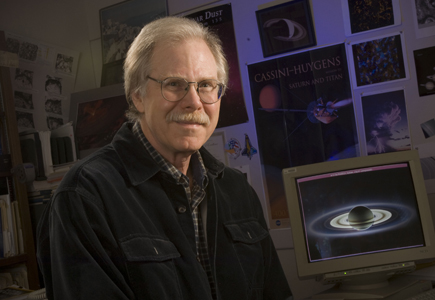
Jeffrey Cuzzi
Research Scientist - NASA Ames Research Center
I am from Pelham, N.Y., which is just north of New York City.
Even though I had already gone to graduate school to study planetary science, my first personal or emotional connection with outer space was the first time I saw Saturn in a pretty big telescope -- the 24 inch one on Mount Wilson that grad students had free access to use. This was several years before I actually started to study Saturn scientifically, but it was a sight I will never forget.
During some observations of Mars and Mercury with a big radio telescope, I was observing Saturn just for fun (Saturn's rings were yet to be discovered). Just at that time, Jet Propulsion Laboratory (JPL) scientists bounced a strong radar signal off Saturn's rings, and it was a real puzzle how the rings could reflect radar waves so well, but yet not emit any radio waves. While trying to resolve this puzzle I started to study simple ring dynamics.
As there weren't many ring experts at that time, I was invited to join the Voyager 1 and Voyager 2 Imaging Team to work on planning the ring images for the Saturn, Uranus, and Neptune encounters.
I'm inspired professionally by the many thousands of truly outstanding and hardworking scientists all around the world, who are motivated not by personal gain, but by the excitement of learning something new about the world we live in. We rely on each other to contribute different pieces of a big puzzle. And I am inspired personally by anyone who works to make the world around them a better place for everyone.
In addition to its spaceflight centers, where spacecraft like Cassini are built and operated, NASA also has several research centers that emphasize basic research and instrument development; these studies very often lead to space missions such as Cassini. And I am one of those researchers. For instance, one of my first jobs at the NASA-Ames Research Center (ARC) was to be the lead scientist on the first Titan Probe study.
It would have to be arriving at JPL for the Voyager 1 Saturn encounter. When I got there I was amazed to see dozens of big media RVs lined up outside JPL. Saturn -- and especially the rings -- was big news! Letting myself into the Imaging Team's area at JPL, I was blown away by how well the images we had planned using my brightness models had turned out -- beautiful, glowing images of the rings in a geometry no one had ever seen. Everyone was ecstatic, including me. It was a great day.
My own career path was not straight by any means, so I'd say be prepared for the unexpected. Stay close to subjects that fascinate you personally, but also ask why is the subject important. Can you tell your friends and family why it's worth your time and their tax money? Respect your colleagues, don't take their skeptical questions as personal insults, and don't be afraid to ask questions of your own. Be aware that you will need, and find, mentors who can help you grow. Have fun!
I enjoy hiking (usually with a camera), making beautiful photos even more beautiful, tending my tomatoes and dwarf fruit tree orchard, and counting waves at the beach. I'm very interested in Paleolithic and Neolithic cultures -- and particularly their mythology.
Learn the basics as best as you can as you go along, even if the ultimate applications are not yet clear. And having some computer programming background is very important.
Planetary science is a global profession.

